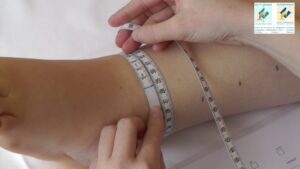Measuring Limb Volume for Lymphedema
Methods for Measuring Limb Volume for Lymphedema
How can you tell if you have lymphedema? Often times, the first sign is a change in the way your arm or leg feels – a feeling tightness, fullness or heaviness. Other signs include visible changes in the appearance of your arm or leg and changes in the way clothing or jewelry fits. Measuring limb volume can confirm development of swelling from lymphedema. Lymphedema therapists specialize in treating lymphedema. They are trained in how to measure limb volume, how to treat lymphedema, and can give you objective information about volume changes caused by lymphedema.
The Tape Method

The tape method is the most common way to measure limb volume for lymphedema. The therapist places a tape around the effected limb at prescribed increments. Measurements are recorded and a formula is used to calculate the limb volume. Measurements of both the involved and non-involved limbs are taken and compared. Advantages of this method are that it is in-expensive, doesn't require special equipment, and has good test-re-test reliability.
The Water Method

Another method of measuring limb volume for lymphedema is water displacement. This method involves placing the involved limb in a special container filled to the top with water. The lymphedema therapist captures the water that spills out and measures how much water is displaced. To use this method, patients must have sufficient mobility to place the involved limb in the container. They must also have sufficient strength and endurance to hold it there until measurements are complete. It can also be fairly messy.
Bioimpedance Spectroscopy
Bioimpedance spectroscopy is a new method of measuring limb volume for lymphedema. It detects extracellular fluid differences in the arms or legs. This helps determine if fluid is building in the at-risk limb. By detecting these changes in the extracellular fluid levels, treatment can start before lymphedema progresses from Stage 0 to Stage 1.
Bioimpedeance measurements are made by passing a harmless electrical signal of very low strength from one point to another. The amount of resistance the current encounters is measured. The measurements are used to calculate a ratio. The ratio is used to determine if there is excessive extra-cellular fluid. The test takes only minutes to perform. It is painless and gives an immediate result.
ImpediMed offers Sozo (greek for healed), a commercially available bioimpedance spectroscopy device. It is designed to aid clinicians in identifying lymphedema and delivers a quick and non-invasive method for measuring extracellular fluid differences. In less than 30 seconds, it measures 256 unique data points to provide patient information, including:
This data allows the therapist to get a detailed understanding of the fluid and tissue status at all stages of lymphedema. And this is very instrumental in early detection. Regular Sozo measurements can help:
- Better aid in clinically assessing for lymphedema in the arms and legs of women and the legs of men.
- Demonstrate extracellular fluid level differences (if present).
ICG: Fluorescent Lymphography Imaging
Indocyanine Green (ICG) lymphography is a relatively new imaging technique. It allows quick visualization of superficial lymph flow in real-time, without radiation exposure.
ICG lymphography allows physicians to precisely and reliably diagnoses, track, and stage lymphedema severity. It accurately captures disruption of lymph flow in all stages of lymphedema - from the subclinical (Stage 0) to more advanced (Stages 1 to 3).
ICG testing takes approximately six hours to complete. Contrast dye is injected into distal superficial lymph channels and the initial imaging captures how the dye moves into the lymph system. Imaging is taken again six hours later to detect how the fluid has moved through the lymph system up to the lymph nodes. Using this method, blockages and impediments to fluid movement are detected.
Researchers are working on developing standard protocols for how to use ICG for lymphatic imaging. And ICG is rapidly becoming the gold standard for determinizing surgical options for patients with lymphedema.
Measuring Limb Volume to Detect and Manage Lymphedema
The key to effective treatment and management of lymphedema is early detection. Measuring limb volume for lymphedema is an essential component of early detection. Thanks to advances in science and technology, doctor's offices and clinics can now access what was once only available to medical researchers. And as insurers recognize the need for and the cost-saving benefits of early detection, the value of bioimpedance spectroscopy and ICG imaging is being increasingly acknowledged. Much progress has been made in reimbursement for these procedures. And who knows! Perhaps one day bioimpedance spectroscopy and ICG imaging will become a benchmark of best practices
